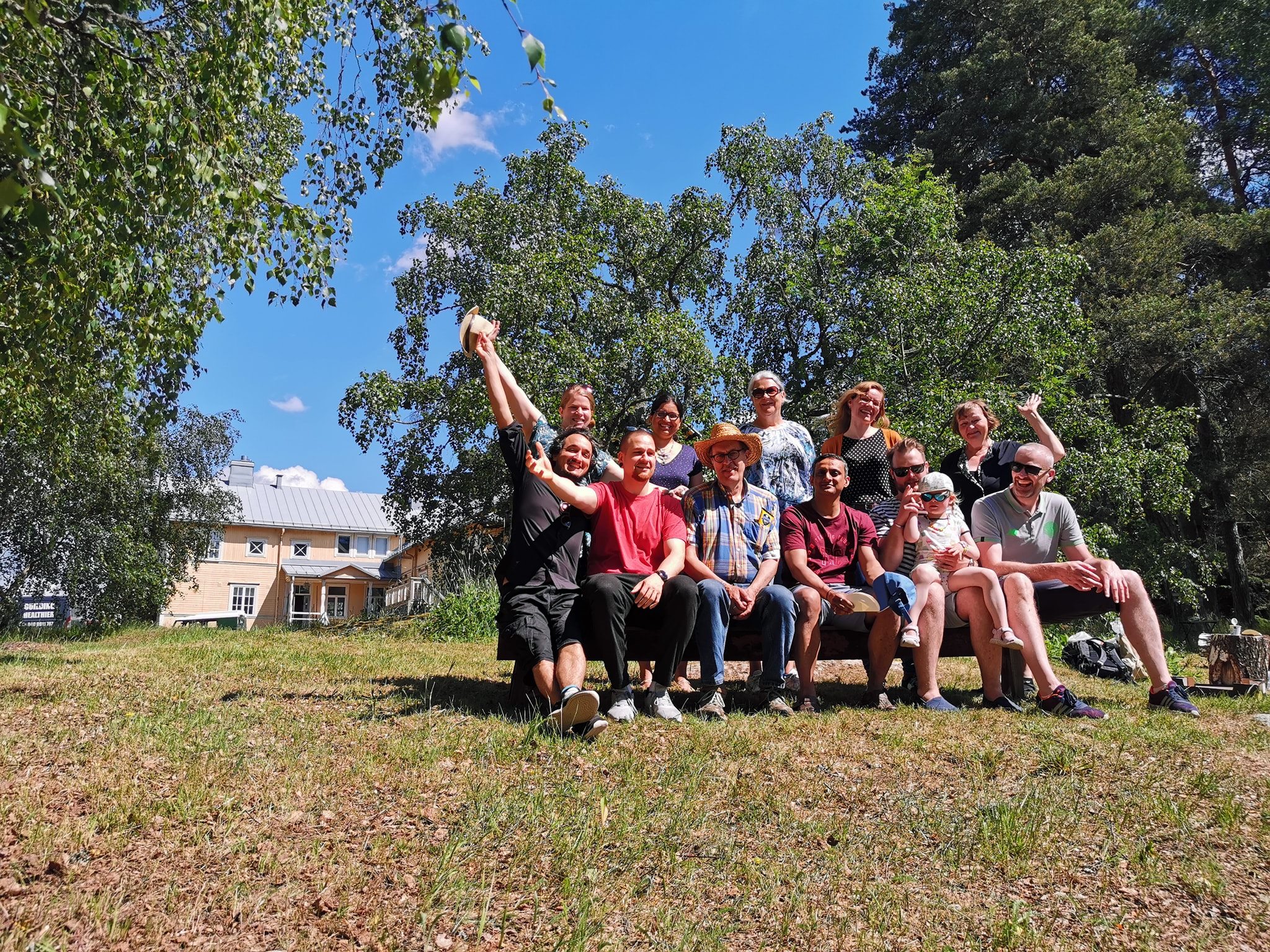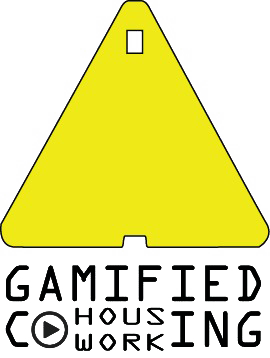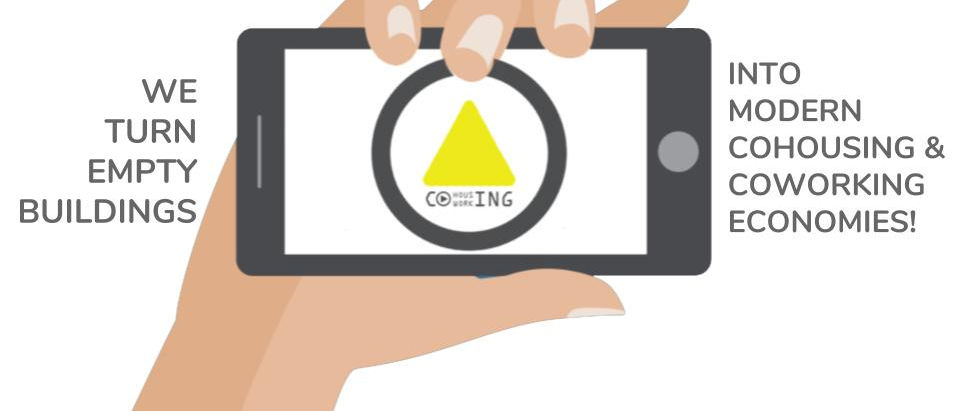Gamified Cohousing, born out of the research of “Architectural Democracy”, addresses two major problems in cities: loneliness and misuse of natural resources. With our business model of “service co-development” and it’s five step implementation plan we can turn any empty building, together with their local owners, into a thriving resilient cohousing and coworking community, regardless of its location.
According to a study of the Tampere University, Finland is the country in western Europe where most heritage buildings are being demolished. The cause seems to be related to the steady increase of more strict building regulations over the last decades and a lack of flexibility towards renovation projects. This has extreme negative consequences. Not only it causes waste of resources (falling short of circular economy goals) but above all, it propels the destruction of communities and of cultural identities.
To provide an impulse towards updating legislation, and to address two major problems in cities, loneliness and misuse of natural resources, the start-up "Gamified Cohousing" was created, born out of the previous research on “Architectural Democracy”. The developed five step plan turns empty buildings into cohousing and coworking economies regardless of the location and of personal’s assets or family disputes around it.
We started the proof of concept with the pilot project of Hyrsylän Koulu in Lohja, Finland. We now just renovated this 120 year old abandoned school into a thriving resilient community.
With a mix of private and shared spaces, people live and work here in modern standards and benefit financially and socially via the facility management app created specifically for this purpose, where daily tasks or rentals can be easily managed in a fun way.
Four families live currently in this former school in modern standards and use a facility management app to be engaged in daily tasks of the house to benefit from it socially and financially. The house is not only a home but also a cultural hub for the small village of Hyrsylä, with many events taking place around the year (music, yoga, lectures, camps, etc.) by using the shared spaces to keep the community engaged and sustain the locals with economic activities.
Please highlight how the project can be exemplary in this context
We see sustainability around three pillars, environmental, political, and economical:
- Environment: Over 10% of our buildings are empty (24% in China) and construction industry emits 44% of all CO2 into the atmosphere. We need to shift our focus towards renovation and build new only as means of supporting the existing infrastructure. Construction is not mainly fuelled by a pressing need on new homes but by market pressures (bloomberg, 2018a). Our work shows that the risk in investment on renovation can be overcome if we integrate a flexible room program adapted to the local contexts and planned as a buffer object for temporary usage around new buildings. In short, build as little as new as possible, modularly so it can grow and most importantly shrink, with low footprint and the inclusion of green space such as greenhouses.
- Political: we are losing the ability to negotiate our personal differences with our neighbours as it is too easy to “click” them away and stay in our bubbles. We know better Hollywood stars than our own neighbours. Loneliness is a serious public-health problem, and it has become not only an epidemic among young adults but also it is older people (in The Guardian 2014). We need to engage in more communal ways of living so we can relearn how to negotiate our differences, at best from childhood. With our proposal, we see a diverse group of modern families and individuals interacting, where rules keep changing to adapt to changing people.
- Economic: Ageing population and millennial’s fluid lifestyles demand a change of the traditional real estate models. A generation is coming where millions will be leaving the housing market rather than entering it. In this context we must be concerned about whether the tech industry will learn real estate faster than real estate learns tech. With our gamification of communal living and with our solutions within service architecture, we are tackling a more flexible lifestyle.
Please highlight how the project can be exemplary in this context
Our Aesthetics goals are at three levels, in the User Experience of the App, on the architecture level by keeping an identity of the old buildings and at a cultural, artistic level in the shared / experimental areas of the cohousing.
- User Experience: We are building a business on a value-based mission that resonates with a new generation of conscious buyers that want to find new ways of living by sustainable development. Shared housing and shared networked economies will transform the concept of requiring a home from a cost calculated decision to a profit driven vision. The house can work for you because it offers you mini jobs. This is all managed via the facility management app, which is of course meant to be highly functional with tasks such as cleaning or food, but also socially engaging. We are thus focusing a great deal on gaming mechanics for this interface, where your avatar is seen on a 3D environment of the house and interact digitally with other users of the house.
- Vernacular Architecture: a constant topic among engineers and architects is functionality Vs Aesthetics. If we turn the upkeeping of existing materials as much as possible intact as a priority, this current clash of opinions slows down, as then the aesthetics of the old also becomes a functionality variable.
- Culture: there are no competitors out there in cohousing that give more than 10% of the total living areas to shared spaces, for communal or experimental activities. This is so because these areas are not sealable and thus represent a burden for the investor. Our model does not see it so. We have over 40% of shared spaces and the value created by these, with the help of the facility management app, is clear. Plenty of activities are created generating an internal economy that is linked to the local one. The house increases value not just financially but aesthetically.
Please highlight how the project can be exemplary in this context
This project was born out of the research of Architectural Democracy, which has a track record on solutions for including urban planning participation, mainly via the gamification of tools or parametrization of design. For example, the Urban Dots game done together with MIT and the Aalto University or the Decisions.City together with Accenture Interactive.
Most of our team at Gamified Cohousing is also working with Architectural Democracy. In fact, we can say we are a spin-off of it, more towards a practical market solution around housing.
Our project offers an app that manages the house. This app is in the form of a game with a 3D and a 2D user interface. Everyone can download this app. Anyone can book a room in the house, for an event, or exchange ideas with the other avatars digitally. The house has several shared spaces that are usually open to the public.
Another feature of inclusiveness and a very important feature of the app is that the rules of co-living are changeable. The users themselves can add or change existing rules. This is not only to allow a higher participation, but this is done because we noticed that most cohousing and coworking spaces around the world failed to realize that there can be no eternal rules, because there are no eternal residents or users. Adaptability of the rules is fundamental to a sustainable update of the community.
Please highlight how this approach can be exemplary
We do not make a division between inclusion, aesthetics, and sustainability. As seen in our approach we integrate this into the whole strategy simultaneously. For example, inclusion is dealt by allowing not only flexible rules in the managing app but also on a modular design architecture of the house, this is a cornerstone of sustainability: the ability to adapt over time. One major problem with the construction industry is the lack of adaptability, it sells the idea that all will remain unchanged forever and thus the investment is perfect. This is also linked to our renovation practices that are linked to Aesthetics: it is wiser to build with light weight structures over a solid foundation, rather than overusing concrete. Staying in this mix of Sustainability and Aesthetics, local materials, such as wood or clay (almost worldwide available) feel better to the user and it is in higher demand. Its maintenance also requires more of local knowledge rather than highly specified one.
When we address our clients, we propose them a 5-stage plan, minimal renovation, cohousing + coworking mix, modular design, gamification of the facility management and service architecture. All these steps aim to combine aesthetics, sustainability, and inclusion. The latter, service architecture makes once again sure that the building does not need to have everything to its users, but it needs to communicate with other local ones. For example, we have a gym and a music hall at our pilot project of Hyrsylän Koulu, that many locals use or rent. But we do not yet have a stable for horses, so we do the same with our neighbors, we rent their services, and this can be easily done with the app. It feels like a sims game, but it is actually your real house and avatar!
Our work regains a sense of belonging at various levels:
- Socially, via the incorporation of a cohousing and coworking mix into any building, we make sure people get together and have a meaningful social life
- Architecturally, by upkeeping the old designs and solutions as much as possible, by leaving the scars of the building visible, to prolong and upkeep a sense of cultural identity. The stories of the building should be visible, so it enrichens the people in it and adds to sense of belonging, to a common cultural identity and group.
- In management, via our application, we make sure people can negotiate differences at different paces and styles. Some of us prefer face to face interactions but others avoid it. With this tool implemented in our projects, we allow for a potential mix and thus a higher diversity of people to be integrated.
- In the public realm, as we offer shared spaces which not only the residents are able to use, but also global citizens can find us online and book a room or event.
- Artistically: the low changes done to the built environment combined with the shared spaces and the managing app allow users to be creative with the spaces and even appropriate them. It allows for a seed-planning (Ricard Sennett)
- Generational, the communal living enabled via the app and shared spaces, via the private and public mix, can have an intergenerational communication and exchange of services, such as baby or dog sitting, exchange of skills, etc.
- By using the local know-hows: we renovate the old building towards the goal of enhancing the local economies so that no matter what location, the building attracts people. To do this we turn the owner of the property into a co-developer with a leasing contract.
After years of a pandemic and now of war, it is clearer than ever that we need smaller clusters of communities within a city or region. Leaving people in shoeboxes in apartments has been proven to be very negative, only benefiting the developers.
Please also explain the benefits that derived from their involvement.
We started this work in 2018 as a start-up. We presented our ideas in an acceleration program of the Helsinki Think Company, and we got awarded for the work. The process gave us a great deal of valuable input in special of the business model. We then got some private and public funding and acquired in 2019 our first abandoned building, an abandoned school in the Finnish countryside. We then implemented a series of cultural programs such as the "Cultural Sauna", live music concerts and music camps in collaboration with the World Music School Helsinki and Artistic Residencies with the support of the Myymälä2 Art Gallery of Helsinki, to invite local people into the house and establish a dialogue.
At the same time, we were doing this, we did all the technical steps needed, such as a new survey of the house, new measurements, and new plans for the renovations.
The interaction with the locals, and the cultural program was fundamental to mature the solutions for the house. Our expertise was clearly not enough to map the local economical needs and thus turn this project into a success.
Our solutions are proving to be very relevant and scalable. Immediately after the incubation phase of the start-up, we were getting calls form other international places to collaborate. This trend kept on growing during and after the completion of our pilot project in 2021. We now have other works ongoing for Portugal, Italy, India, Angola, and Germany.
This feedback made us realize or better, confirm what we suspected, there is a hunger for modern cohousing solutions. The past attempts of communal living were important to realize the mistakes that need to be improved. For example, in Switzerland or even Germany, where cohousing is growing, we see the same mistakes being applied. The rules of interaction and design of the spaces are too rigid, and it assumes a certain type of residents. For us this is a fundamental part of our work, both the app and the architecture must allow adaptability to allow different people to use it over time.
We believe we are tackling the global challenge of housing shortage, loneliness, and misuse of resources. The buildings we are renovated would have stayed empty or would have been destroyed most certainly, instead they are filled with life and economic activity. We are reusing old communities mirrored in old buildings, turning them into modern hubs of diversity of living.
Our business model is based on turning every single or group of owners into a co-developer. We are not just consultants, nor developers nor just architects, we are a mix of all, and we want to be partners of these projects with the normal property owner, so we can turn every empty building around the world into communities. We innovate at different levels:
In Cohousing: At a national level, Finland, the market for cohousing is growing but the provided solutions are very limited and so is the legislation. The shared spaces proposed by construction companies (eg. Fira Oy) are always under 10% of the overall living area and the tasks during its operational life are minimal (eg. MaltaTalo). In the very few modern cohousing projects realized in Finland and worldwide, shared spaces are seen as a risky investment not as a potential source of revenue.
In “Developer as a Service”: There is no competition. Construction companies do not offer a full range of integration services for the client. When the construction companies are also developers, they analyse solely the market trend for the next 5 years so the ROI is assured. There is no larger sustainable plan in sight nor any plan of communal integration. The advantage of partnering with a client and turning them into co-developers assures a more sustainable construction outcome.
In Renovation: Our renovation methods have been highly efficient. We have used high accurate tools to scan the buildings with low tech methods such as real time stereo photogrammetry based on the work of one of our partners, the University of Coimbra’s IT department, and their award-winning algorithms. There is no competition in this field.
In “Facility Management app”: There are some solutions like workero or more 3D alike environments like from Tietoa. But these are either not customized to the real 3D of the property nor are gamified. Meaning there is no game mechanics component to the interaction, so the interface usage rates remain low.
Please provide clear documentation, communication of methodology and principles in this context.
We are very open about our process, despite being a business. Here some examples of this collaboration and dissemination activity:
- Publication at the SBEfin engineering conference on emerging concepts for sustainability, with a scientific paper.
- We have developed and improved our facility management app together with universities within their master programs, for example in 2019 and 2021 with the Metropolia University: https://www.youtube.com/watch?v=JAxVCM15h8k
- We have published about our process of upcycling a kitchen.
- We presented our work at the Venice Biennale of Architecture of 2021 and at the Moscow Museum of Architecture in 2019, and did several workshops on Gamified Cohousing in China, at the Tongji Design University and in Finland at Aalto University.
- We have been inviting internees and volunteers to work with us so we get fresh perspectives (for example from the Excelia Business School in La Rochelle, France).
- We have been exchanging ideas and talks with other architects such as Dorte Mandrup or other cohousing for example the Ryozan Park of Japan, with whom we exhibited our work in Moscow.
- We have been invited to several hackathons, for example: Ultrahack
- Our work has been published in several magazines, and newspapers such as Financial times and the largest Finnish Newspaper, Helsingin Sanomat: https://www.hs.fi/elama/art-2000006220733.html Or design magazines: https://www.meillakotona.fi/artikkelit/hyrsylan-uusi-elama
- We presented our work at the World Summit on Digital Built Environment 2019 and at The Habitare fair, which has over 40 000 visitors.
- We have been active in social media in fb: https://www.facebook.com/GamifiedCohousing and Instagram: https://www.instagram.com/cohousing_gamified/



@CoHouseIt Oy, 2021
Content licensed to the European Union.